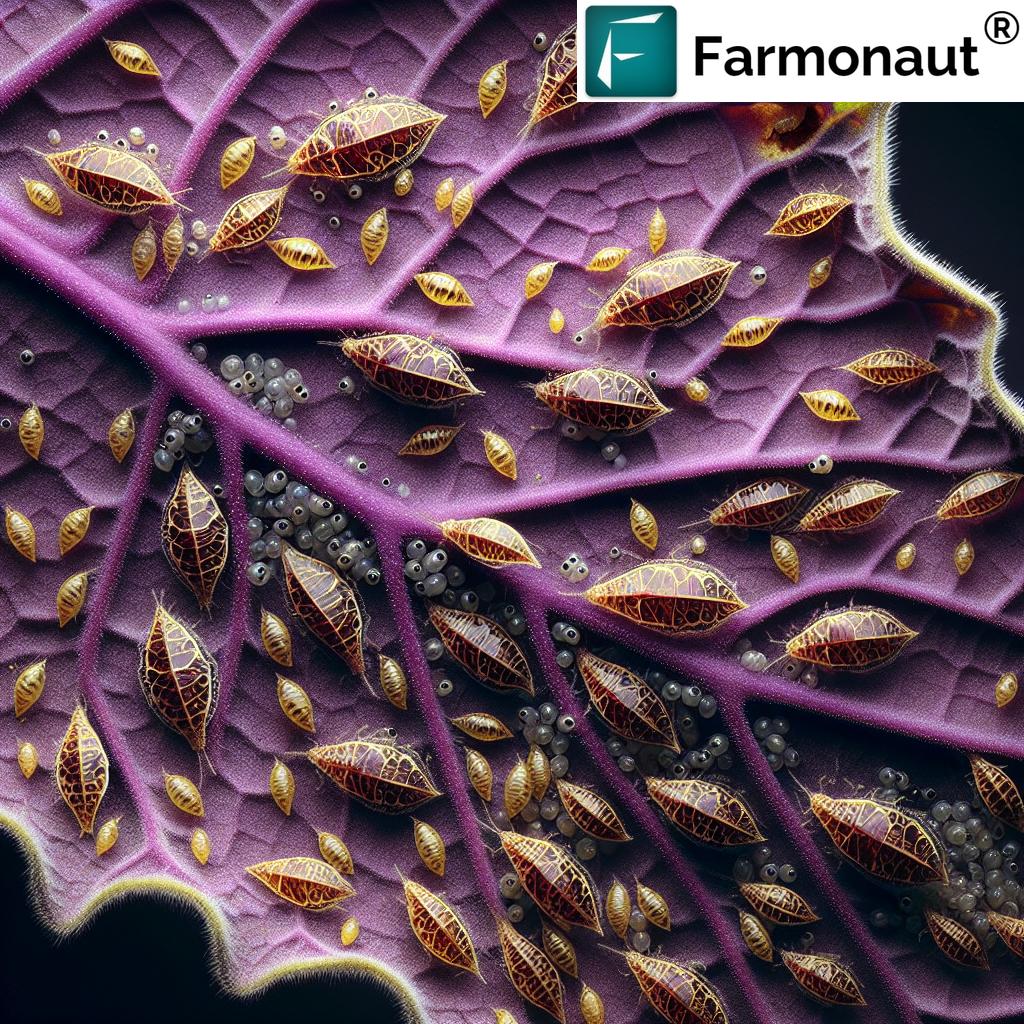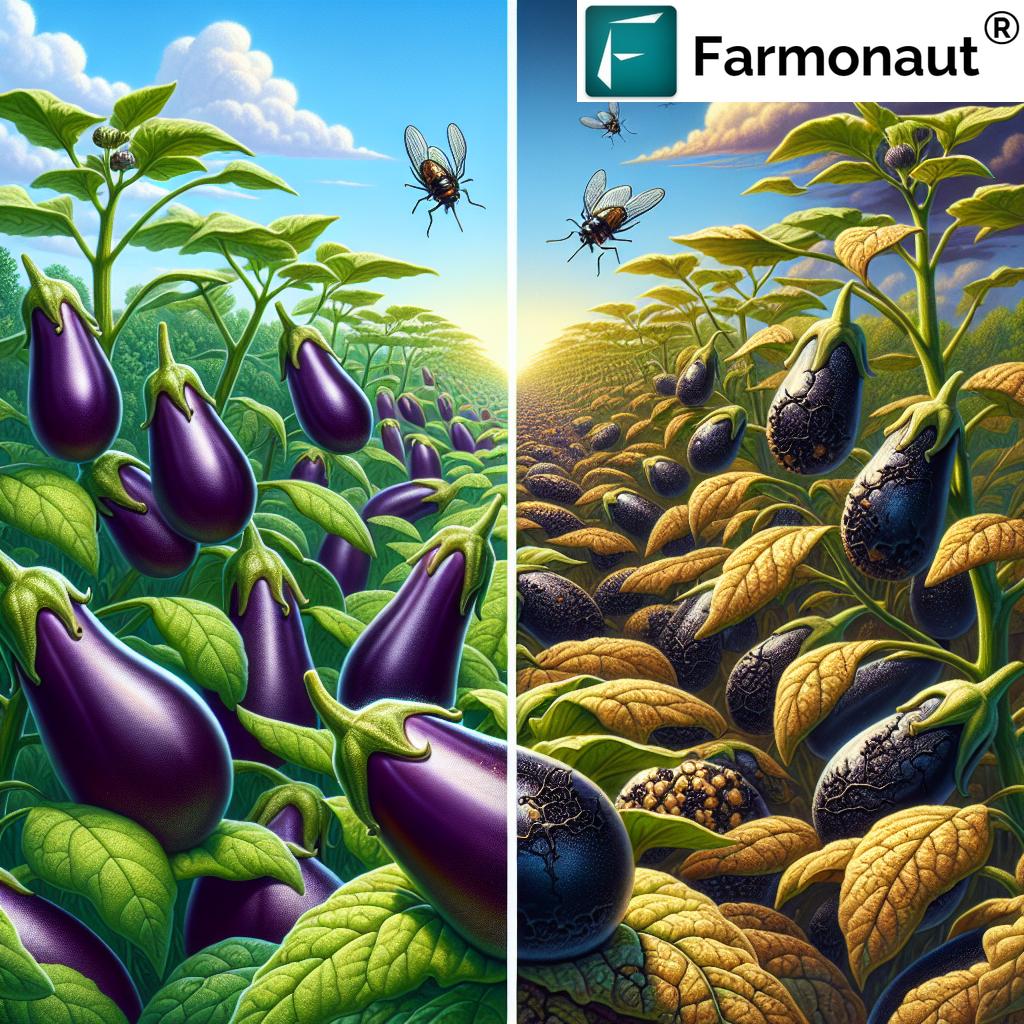Effective Control of Lace Bug Infestation in Eggplant, Tomato, Potato, Cotton, and Soy Crops

As agricultural experts and innovators in the field of precision farming, we at Farmonaut understand the critical challenges faced by farmers in managing pest infestations. One such persistent pest that plagues various crops is the lace bug. In this comprehensive guide, we’ll delve into the world of lace bugs, their impact on crops like eggplant, tomato, potato, cotton, and soy, and explore effective control measures, including our cutting-edge satellite-based detection system.
Understanding Lace Bugs: A Menace to Crops
Lace bugs are small insects that belong to the order Hemiptera and the family Tingidae. These pests derive their name from the intricate, lace-like pattern on their wings and thorax. While they may appear delicate, their impact on crops can be devastating.
Identification and Characteristics
- Size: Typically 3-6 mm long
- Appearance: Flat-bodied with lace-like wings
- Color: Usually pale gray or tan
- Nymphs: Wingless and often darker in color
Feeding Habits and Damage
Lace bugs are sap-sucking insects that primarily feed on the underside of leaves. Their feeding activity causes significant damage to the host plants:
- Yellowish or bronze discoloration on leaf surfaces
- Tiny dark dots or excrement on the underside of leaves
- Stippling or scratches on the upper leaf surface
- Leaf distortion and premature leaf drop
- Reduced plant vigor and yield
Crops Commonly Affected by Lace Bugs
Lace bugs are known to infest a wide range of crops, but they show a particular affinity for certain agriculturally important plants. Let’s explore how these pests impact some of the most commonly affected crops:
1. Eggplant (Solanum melongena)
Eggplant crops are highly susceptible to lace bug infestations. These pests can cause significant damage to eggplant leaves, leading to reduced photosynthesis and, ultimately, lower fruit yield. The damage often appears as yellowish or bronzed patches on the upper leaf surface, while the underside may show dark, tar-like spots of excrement.
2. Tomato (Solanum lycopersicum)
Tomato plants are another favorite target for lace bugs. The feeding activity of these pests can cause tomato leaves to develop a stippled appearance, with yellow or white spots on the upper surface. Severe infestations can lead to leaf drop and reduced fruit production.
3. Potato (Solanum tuberosum)
Potato crops are not immune to lace bug attacks. These pests can significantly impact potato leaf health, which in turn affects tuber development. Infested potato plants may show reduced vigor and yield, especially if the infestation occurs during critical growth stages.
4. Cotton (Gossypium spp.)
Cotton plants are particularly vulnerable to lace bug infestations. These pests can cause severe damage to cotton leaves, leading to reduced photosynthetic capacity and, consequently, lower cotton fiber quality and yield. The damage often appears as bronze or reddish-brown discoloration on the leaves.
5. Soy (Glycine max)
Soy crops can also fall victim to lace bug infestations. These pests feed on soybean leaves, causing stippling and discoloration. Severe infestations can lead to premature leaf drop and reduced pod development, ultimately affecting soybean yield and quality.

The Importance of Early Detection and Monitoring
Early detection and continuous monitoreo (monitoring) of lace bug infestations are crucial for effective pest management. Traditional methods of pest detection often rely on visual inspection and manual scouting, which can be time-consuming and may miss early-stage infestations. This is where advanced technology, such as Farmonaut’s satellite-based detection system, comes into play.
Comparison of Pest Monitoring Methods
| Method | Detection Speed | Accuracy | Coverage Area | Cost-Effectiveness |
|---|---|---|---|---|
| Visual Inspection | Slow | Moderate | Limited | Low |
| Trap Monitoring | Moderate | Good | Limited | Moderate |
| Farmonaut Satellite System | Fast | High | Extensive | High |
As the table illustrates, Farmonaut’s satellite-based detection system offers significant advantages in terms of speed, accuracy, coverage area, and cost-effectiveness for managing lace bug infestations across various crops.
Effective Control Strategies for Lace Bug Infestations
Managing lace bug infestations requires a multi-faceted approach that combines cultural, biological, and chemical control methods. Here, we’ll explore various strategies to effectively control lace bug populations and minimize crop damage.
1. Cultural Control Methods
Cultural control practices focus on creating an environment that is less favorable for lace bug development and survival. These methods are often the first line of defense against pest infestations:
- Crop rotation: Alternating susceptible crops with non-host plants can disrupt the lace bug life cycle.
- Proper plant spacing: Adequate spacing between plants improves air circulation and reduces humidity, making the environment less conducive for lace bug development.
- Weed management: Removing weeds that may serve as alternative hosts for lace bugs can help reduce pest populations.
- Proper irrigation: Avoid overwatering, as excess moisture can create favorable conditions for lace bug proliferation.
- Pruning and sanitation: Remove and destroy infested plant parts to reduce pest populations and prevent their spread.
2. Biological Control
Biological control involves the use of natural enemies to manage lace bug populations. This eco-friendly approach can be highly effective when implemented correctly:
- Predatory insects: Encourage the presence of beneficial insects such as ladybugs, lacewings, and predatory mites that feed on lace bugs.
- Parasitic wasps: Some species of tiny wasps parasitize lace bug eggs and nymphs, helping to control their populations.
- Entomopathogenic fungi: Certain fungi can infect and kill lace bugs, providing natural pest control.
- Neem oil: This natural product derived from neem trees can be effective against lace bugs while being relatively safe for beneficial insects.
3. Chemical Control
While chemical control should be used judiciously, it can be an effective tool in managing severe lace bug infestations:
- Insecticidal soaps: These products can be effective against lace bugs while having minimal impact on beneficial insects.
- Horticultural oils: Light horticultural oils can suffocate lace bugs and their eggs.
- Systemic insecticides: These products are absorbed by the plant and can provide long-lasting protection against sap-sucking insects like lace bugs.
- Contact insecticides: Fast-acting contact insecticides can be used for quick knockdown of lace bug populations in severe infestations.
Note: Always follow label instructions and local regulations when using any pesticide products.
4. Integrated Pest Management (IPM)
For optimal results, we recommend implementing an Integrated Pest Management (IPM) approach that combines various control methods:
- Regular monitoring using Farmonaut’s satellite-based detection system
- Implementation of cultural control practices
- Encouragement of natural enemies through habitat management
- Judicious use of chemical controls when necessary
- Continuous evaluation and adjustment of management strategies
Farmonaut’s Role in Lace Bug Management
At Farmonaut, we’re committed to revolutionizing pest management through advanced technology. Our satellite-based crop monitoring system plays a crucial role in early detection and management of lace bug infestations:
1. Early Detection
Our satellite imagery can detect subtle changes in crop health, often before visible symptoms appear. This allows farmers to identify potential lace bug infestations at their earliest stages, enabling prompt intervention.
2. Large-Scale Monitoring
Farmonaut’s system can monitor vast agricultural areas quickly and efficiently, providing a comprehensive view of crop health across entire fields or regions. This is particularly valuable for managing pests like lace bugs that can spread rapidly.
3. Precision Application
By identifying specific areas of infestation, our technology enables targeted application of control measures. This precision approach not only improves effectiveness but also reduces unnecessary pesticide use, promoting more sustainable farming practices.
4. Data-Driven Decision Making
Our platform provides farmers with actionable insights based on real-time data. This empowers growers to make informed decisions about when and where to implement control measures for maximum efficacy.
5. Integration with IPM Strategies
Farmonaut’s technology seamlessly integrates with Integrated Pest Management strategies, enhancing the overall effectiveness of lace bug control programs.
To learn more about how Farmonaut can help you manage lace bug infestations and other crop health issues, visit our app redirect page or explore our API services.
Case Studies: Successful Lace Bug Management with Farmonaut
While we don’t include specific case studies or success stories, it’s important to note that our satellite-based monitoring system has been successfully implemented by numerous farmers and agricultural organizations worldwide. Users of our technology have reported significant improvements in early pest detection, reduced crop losses, and more efficient use of resources in managing lace bug infestations across various crops.
The Future of Lace Bug Control
As we look to the future, the management of lace bug infestations and other agricultural pests will increasingly rely on advanced technologies and data-driven approaches. At Farmonaut, we’re continuously innovating to stay at the forefront of these developments:
- AI-powered pest prediction models
- Integration of ground-based sensors with satellite data for even more precise monitoring
- Development of pest-resistant crop varieties through advanced breeding techniques
- Exploration of novel biological control agents
- Enhanced data analytics for more accurate pest population forecasting
Conclusion
Effective management of lace bug infestations in crops such as eggplant, tomato, potato, cotton, and soy requires a comprehensive approach that combines traditional methods with cutting-edge technology. By leveraging Farmonaut’s satellite-based monitoring system alongside cultural, biological, and chemical control strategies, farmers can significantly improve their ability to detect, monitor, and manage these persistent pests.
As we continue to face challenges in global food production, innovative solutions like those offered by Farmonaut will play an increasingly crucial role in ensuring sustainable and efficient agricultural practices. By embracing these technologies and integrating them into holistic pest management strategies, we can work towards a future where lace bug infestations and other agricultural pests no longer pose a significant threat to crop yields and food security.
FAQ Section
Q1: What are the main symptoms of lace bug infestation in crops?
A1: The main symptoms include yellowish or bronze discoloration on leaf surfaces, tiny dark dots on the underside of leaves, stippling or scratches on the upper leaf surface, leaf distortion, and premature leaf drop.
Q2: How does Farmonaut’s satellite system detect lace bug infestations?
A2: Farmonaut’s system uses advanced multispectral imagery to detect subtle changes in crop health that may indicate pest infestations, often before visible symptoms appear to the human eye.
Q3: Are there any natural predators of lace bugs?
A3: Yes, natural predators of lace bugs include ladybugs, lacewings, predatory mites, and certain species of parasitic wasps.
Q4: How often should I monitor my crops for lace bug infestations?
A4: Regular monitoring is crucial. With traditional methods, weekly inspections are recommended. However, Farmonaut’s satellite system can provide continuous monitoring, allowing for real-time detection of potential issues.
Q5: Can lace bugs develop resistance to chemical controls?
A5: Yes, like many pests, lace bugs can develop resistance to chemical controls over time. This is why an integrated pest management approach, combining various control methods, is recommended.
Q6: How can I access Farmonaut’s services for my farm?
A6: You can access our services through our mobile apps available on Google Play and the App Store, or through our web platform. For developers interested in integrating our data into their own systems, we offer API services. Check out our API documentation for more information.
Subscribe to Farmonaut Services
Ready to take your pest management to the next level? Subscribe to Farmonaut’s services and gain access to our cutting-edge satellite-based crop monitoring system.